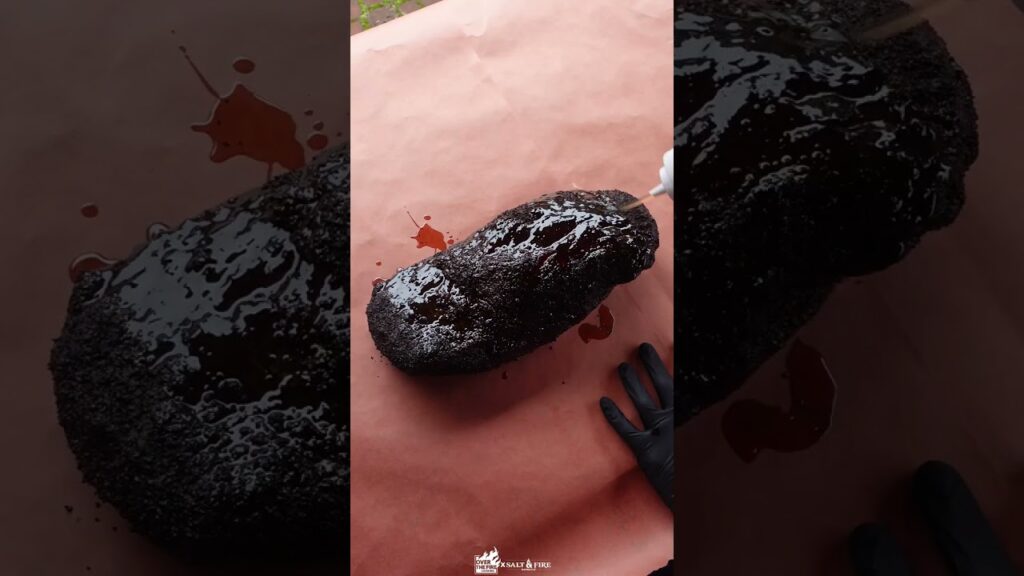Smoked Brisket Recipe Over The Fire Cooking by Derek Wolf shows you how to achieve a tender, smoky brisket with a deep bark and buttery interior that’s become a BBQ favorite. You’ll learn how balancing smoke, time, and temperature brings out rich beef flavor and that satisfying pull-apart texture.
This article outlines the full recipe with an exact ingredients list, step-by-step smoking instructions including cook times and target internal temperatures, practical tips on wood choices and rubs, and serving suggestions to complete the meal. Follow the clear safety cues and finishing notes so you can reproduce the results demonstrated by Derek Wolf and @saltfirebbq.
Article Title and Credit
Title: Smoked Brisket Recipe Over The Fire Cooking by Derek Wolf
You’re reading the Smoked Brisket Recipe attributed to Derek Wolf and his Over The Fire Cooking series. This recipe lays out the classic Salt-and-Pepper Texas-style approach as presented in the Over The Fire Cooking video featuring Salt Fire BBQ techniques.
Credit: Over The Fire Cooking video featuring Salt Fire BBQ techniques
This recipe and technique are credited to Over The Fire Cooking with Salt Fire BBQ influence — you’re following the straightforward, tried-and-true salt-and-pepper brisket method highlighted in that video.
Video reference: Over The Fire Cooking — Derek Wolf (source video for recipe details)
The details here are drawn from Derek Wolf’s Over The Fire Cooking presentation of Salt Fire BBQ’s brisket walkthrough. Use the video as a visual reference while you follow the written steps below.
Author attribution: Derek Wolf / Over The Fire Cooking
The recipe and method are attributed to Derek Wolf and the Over The Fire Cooking channel, with techniques inspired by Salt Fire BBQ.
Social links: YouTube channel, Instagram, Facebook, Pinterest, TikTok (as credited in source)
You can find Derek Wolf and Over The Fire Cooking on YouTube, Instagram, Facebook, Pinterest, and TikTok as credited in the source material for visual demonstrations and additional tips.
Recipe Overview and Yield
Short overview of the dish: classic low-and-slow smoked whole brisket with a salt-and-pepper approach inspired by Salt Fire BBQ
You’re preparing a classic low-and-slow whole packer brisket using a minimalist salt-and-pepper rub that lets high-quality beef and smoke flavor shine. The method focuses on anatomy-aware trimming, steady low heat, and careful probing so the brisket becomes tender and flavorful without fancy injections or sugary glazes.
Flavor profile: savory beefy crust (bark), deep smoke, tender, juicy interior
You’ll get a savory, beef-forward flavor profile: a crisp, peppery bark on the outside, a clean, deep smoke note throughout, and a tender, juicy interior that pulls cleanly when sliced. The salt-and-pepper approach produces a classic Texas-style bite where the meat itself is the star.
Why it’s popular for BBQ: reliable technique for large gatherings, builds great bark and smoke ring, versatile for slices or burnt ends
This approach is popular because it’s reliable for feeding a crowd, scales easily for a whole packer brisket, and consistently builds a robust bark and attractive smoke ring. Once finished, you can slice it for traditional service or cube and caramelize the point for burnt ends.
Yield guideline: one whole packer brisket (10–12 lb) serves approximately 10–14 people; adjust quantities proportionally
A 10–12 lb whole packer brisket typically serves about 10–14 people depending on portion sizes and sides. If you need to feed more or fewer people, scale the brisket size and rub quantities proportionally.

This image is property of i.ytimg.com.
Ingredients List
Brisket: 10–12 lb whole packer brisket (flat + point), well-trimmed by butcher or trimmed to below instructions
You’ll need one whole packer brisket — including both flat and point — weighing 10–12 lb. Ask your butcher to trim it close to the described specs or trim it yourself following the trimming guidance below.
Primary rub: 1/2 cup kosher salt
Use 1/2 cup kosher salt as half of the primary rub. This is the salt component in equal volume to the pepper for classic balance.
Primary rub: 1/2 cup coarse black pepper (freshly cracked coarse grind preferred)
Use 1/2 cup coarse black pepper (freshly cracked, coarse grind preferred) as the other half of the primary rub. The coarse grind gives texture to the bark and bold pepper flavor.
Optional aromatics (strictly optional): small dusting of granulated garlic or onion powder to taste — use only if following a variation
If you want a slight variation, you may lightly dust granulated garlic or onion powder to taste. This is strictly optional; the traditional Salt Fire style often keeps it to salt and pepper only.
No injection or mop required for traditional salt-and-pepper method (omit if strictly following Salt Fire style)
No injection, mop, or sauce is required for this traditional method — you’ll omit them if you’re staying true to Salt Fire BBQ’s minimalist approach.
Optional spritz: apple juice or water for intermittent moisture (use sparingly if desired)
If you prefer to spritz the brisket during the cook, have apple juice or water on hand. Use sparingly and only if the surface appears overly dry during the early to mid stages of the cook.
Essential Tools and Safety Items
Smoker or grill capable of holding steady 225°F (charcoal offset, pellet, electric, or gas with smoking wood)
You’ll need a smoker or grill that can hold a steady 225°F (107°C). This can be a charcoal offset, pellet smoker, electric smoker, or a gas grill set up for smoking with added wood. Consistent temp control is more important than the exact model.
Two high-quality digital meat probes or instant-read thermometer
Use two reliable digital meat probes or an instant-read thermometer to monitor both ambient smoker temperature and the brisket’s internal temp. Accurate probes are essential for timing and doneness.
Butcher paper or heavy-duty aluminum foil for wrapping (if using Texas crutch)
Have butcher paper (preferred for preserving bark) or heavy-duty aluminum foil ready for wrapping during the stall. Both will speed the cook and help push through the stall; butcher paper retains texture better.
Sharp slicing knife and firm cutting board
Prepare a sharp slicing knife and a sturdy cutting board so you can trim, rest, and slice the brisket cleanly when it’s done.
Insulated cooler or warming box and towels for resting
Plan to rest the brisket in an insulated cooler or a warming box wrapped in towels to hold temperature while the meat relaxes. Proper resting helps redistribute juices and improves final tenderness.
Food-safety items: gloves, separate cutting board for raw meat, thermometer for final check
For food safety, use gloves if you prefer, keep a separate cutting board for raw meat, and use a thermometer to confirm internal temperature targets. Always practice safe handling and clean surfaces and tools after trimming raw brisket.

This image is property of images.pexels.com.
Preparing and Trimming the Brisket
Inspect the brisket: identify fat cap, point and flat, silver skin, and large seams of fat
Begin by inspecting the brisket on your work surface. Identify the fat cap (the thick layer of fat on one side), the point and flat muscles, any silver skin, and large seams of excess fat. Understanding the anatomy helps you trim for even cooking and good bark formation.
Trim the fat cap: remove thick sections but leave approximately 1/4 inch of fat to protect and flavor the meat
Trim the fat cap so that approximately 1/4 inch of fat remains across the surface. Remove any overly thick sections that won’t render and could cause uneven cooking, but leave enough fat to protect the meat from direct heat and add flavor as it renders.
Remove loose fat and silver skin that will prevent rub adhesion
Remove loose pockets of fat, hard seams, and silver skin that will prevent the rub from adhering or that won’t render during the long cook. Clean surfaces will take rub and smoke more consistently.
Square the brisket: trim excess irregular fat to promote even cooking and fit the smoker
Square off the brisket by trimming irregular bits and tapering the edges so the meat cooks evenly and fits comfortably in your smoker. Removing very thin areas prevents over-drying and helps achieve a uniform finish.
Weigh and label the brisket so you can estimate total cook time
Weigh the finished trimmed brisket and, if you’re cooking multiple pieces, label them. A 10–12 lb packer will typically take many hours; knowing the exact weight helps you estimate total cook time and pacing.
Making and Applying the Rub
Combine rub: use kosher salt and coarse black pepper in equal volumes (1/2 cup each for a 10–12 lb packer)
Combine 1/2 cup kosher salt and 1/2 cup coarse black pepper in equal volumes to make the primary rub for a 10–12 lb packer. Stir gently to distribute, but remember this is a two-ingredient rub and simplicity is the goal.
Apply rub generously: coat all sides and corners, pressing the rub into the surface for an even crust
Apply the rub generously to all sides and corners of the trimmed brisket, pressing it into the meat to ensure even adhesion. Make sure seams and crevices are well coated so the bark develops uniformly.
Timing after rub: allow 15–60 minutes at room temperature for surface moisture to tack (no mandatory long dry brine required for salt-and-pepper style)
After applying the rub, let the brisket rest at room temperature for 15–60 minutes to allow surface moisture to tack up and the rub to adhere. There’s no mandatory long dry-brine step for the Salt Fire style — a short rest is sufficient.
Optional: apply a thin binder (neutral oil) only if needed for rub adhesion — traditional Salt Fire method usually skips binders
If your rub isn’t adhering well, you can use a thin coat of a neutral oil as a binder, but this is usually unnecessary for this salt-and-pepper method. Traditional Salt Fire technique typically skips binders to keep the surface dry for better bark.

This image is property of images.pexels.com.
Fire and Smoker Parameters
Target smoker temperature: steady 225°F (107°C) to 250°F (121°C); most consistent results at 225°F
Set your smoker to a steady 225°F (107°C). You may run up to 250°F (121°C) if needed for faster cooks, but most consistent results are achieved at 225°F. The lower temperature encourages even rendering and bark development.
Recommended wood: post oak or oak for a classic Texas profile; alternatives include hickory or pecan in small amounts
For authentic Texas-style smoke, use post oak or oak wood as your primary fuel. If you want a stronger or slightly sweeter smoke, you can mix in small amounts of hickory or pecan, but keep it balanced so it doesn’t overpower the meat.
Smoke amount: aim for a clean, thin blue smoke; avoid heavy, sooty smoke that will bitter the meat
Aim for clean, thin blue smoke rather than billowing white or sooty smoke. Thin blue smoke imparts a pleasant flavor; heavy or sooty smoke can result in a bitter taste.
Airflow and consistency: maintain a steady supply of fuel and consistent vent settings for stable temps; avoid large temp swings
Maintain steady airflow and keep fuel supply consistent to avoid large temperature swings. Stable temps are essential for predictable cook progression and good texture.
Initial Smoking Stage
Placement in smoker: place brisket fat cap up for radiant heat protection and fat rendering; orient thicker end closer to heat if using offset
Place the brisket on the smoker with the fat cap up so the fat can render down into the meat, and the bark receives radiant heat. If you’re using an offset smoker, orient the thicker point end toward the heat source for more even cooking.
Initial cook: smoke unwrapped until internal temperature reaches approximately 150–165°F (66–74°C)
Smoke the brisket unwrapped until it reaches an internal temperature of approximately 150–165°F (66–74°C). This phase develops the initial bark and allows smoke to penetrate the exterior.
Smoke monitoring: check probe temperatures periodically without over-opening the smoker; add minimal fuel to maintain temperature
Monitor smoker and meat temps using your probes and avoid opening the smoker too often. When adding fuel, do so in small amounts to maintain a steady temperature rather than causing spikes or lulls.
Optional spritzing: spritz the surface every 45–60 minutes with apple juice or water if the surface looks overly dry — optional and light-handed
If the surface looks excessively dry during the initial stage, you can lightly spritz the brisket every 45–60 minutes with apple juice or water. This is optional and should be done sparingly to avoid prolonged stall from excess evaporation.

This image is property of images.pexels.com.
Mid-Cook: Stall, Wrapping, and the Texas Crutch
Recognize the stall: internal temperature may plateau (stall) around 150–170°F due to evaporative cooling
Expect to encounter the stall — a plateau in internal temperature commonly occurring around 150–170°F as evaporative cooling counters heat gain. Recognizing the stall helps you decide when to wrap.
Decision point: wrap in butcher paper (preferred by many pitmasters) or heavy-duty foil when internal temp is in the 150–165°F range or when probe shows noticeable tug
When the internal temp reaches roughly 150–165°F or when the probe meets significant resistance (a noticeable tug), decide whether to wrap. Many pitmasters prefer butcher paper to preserve some bark texture, while foil will speed the cook more aggressively.
Wrapping method: tightly wrap to limit evaporation while preserving bark quality (butcher paper yields better bark than foil), seal seams well
Wrap the brisket tightly in butcher paper or foil to limit evaporation and push through the stall. If using butcher paper, wrap snugly and fold seams to retain heat while still allowing the bark to hold up better than foil-wrapped meat.
Continue cooking wrapped brisket until internal temperature reaches 198–203°F (92–95°C) and probe slides in with little resistance
Return the wrapped brisket to the smoker and continue cooking until the internal temperature reaches 198–203°F (92–95°C). Use the probe test as your final cue: the probe should slide in with little resistance and the meat should feel tender. This temperature range is the typical target for a tender brisket.
Conclusion
Recap of key steps: trim, salt-and-pepper rub, low-and-slow smoke at 225°F, wrap during stall, finish to 198–203°F, rest, slice against the grain
To recap: trim the brisket leaving about 1/4 inch of fat, apply a 1:1 rub of 1/2 cup kosher salt and 1/2 cup coarse black pepper, smoke low-and-slow at about 225°F, wrap in butcher paper or foil during the stall, finish the cook when the internal temp reaches 198–203°F and the probe slides in easily, then rest the meat before slicing across the grain.
Final encouragement: practice patience—consistent temp control and probing for tenderness are more important than strict timelines
Be patient — consistent temperature control and probing for tenderness are far more important than sticking to a rigid schedule. For a 10–12 lb packer, plan several hours; expect a cook that often takes in the neighborhood of 10–14 hours total depending on your smoker and conditions. Trust your thermometer and your feel.
Key takeaways for repeatable success: quality brisket, simple rub, steady smoke, and proper resting
For repeatable success: choose a quality brisket, keep the rub simple and even, maintain a steady clean smoke and temperature, and rest the brisket properly before slicing. Those elements will yield consistent tenderness and flavor.
Call to action: try the method, take notes on your cook, and follow Derek Wolf/Over The Fire Cooking for visual reference and tips
Try this method on your next brisket cook, take notes on probe temps, times, and results, and refer to Derek Wolf/Over The Fire Cooking videos for visual reference and additional tips. Each cook teaches you something, so adjust and refine based on your smoker and preferences.
Additional tips: keep spare probe cables and batteries, trim and save trimmings for burnt ends, and if you’re serving later, hold the brisket wrapped in an insulated cooler to maintain warmth without overcooking. For food safety, always keep raw meat separate from ready-to-eat items, wash hands and surfaces after handling raw brisket, and confirm safe handling temperatures with your thermometer.
Serving suggestions: slice the brisket against the grain into 1/4-inch to 1/2-inch slices for serving or separate the point for burnt ends. Pair the brisket with classic sides such as pickles and onions, potato salad, coleslaw, baked beans, and cornbread. Serve sauce on the side so guests can add it as desired, and offer strong-flavored sides that complement the savory, peppery bark.
Enjoy the process and the delicious results — smoking a whole packer brisket is as rewarding as it is flavorful.
